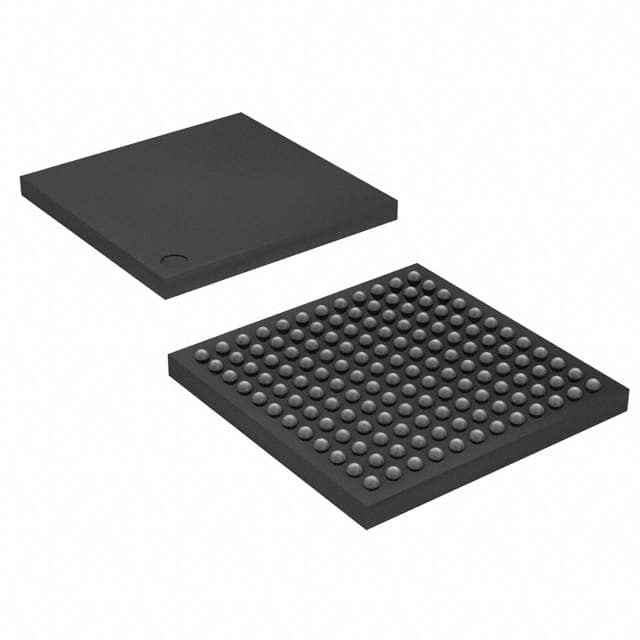Viz Specifikace pro podrobnosti o produktu.

AT91SAM7L128-CU
Product Overview
- Category: Microcontroller
- Use: Embedded systems, Internet of Things (IoT) devices
- Characteristics: Low-power consumption, high-performance, compact size
- Package: Chip-scale package (CSP)
- Essence: ARM-based microcontroller with integrated peripherals
- Packaging/Quantity: Available in tape and reel packaging, quantity varies based on customer requirements
Specifications
- Microcontroller Core: ARM7TDMI-S
- Clock Speed: Up to 55 MHz
- Flash Memory: 128 KB
- SRAM: 16 KB
- Operating Voltage: 1.8V - 3.6V
- I/O Pins: 32
- Communication Interfaces: UART, SPI, I2C, USB
- Analog-to-Digital Converter (ADC): 10-bit, 8 channels
- Timers/Counters: 4 x 16-bit timers, 1 x watchdog timer
- Operating Temperature Range: -40°C to +85°C
Detailed Pin Configuration
The AT91SAM7L128-CU microcontroller has a total of 64 pins. The pin configuration is as follows:
- Pins 1-32: General-purpose I/O (GPIO) pins
- Pins 33-40: Analog input pins for the ADC
- Pins 41-48: Communication interface pins (UART, SPI, I2C, USB)
- Pins 49-52: Timer/counter pins
- Pins 53-56: Power supply and ground pins
- Pins 57-64: Reserved for future use
Functional Features
- High-performance ARM7TDMI-S core for efficient processing
- Low-power consumption for extended battery life in portable devices
- Integrated peripherals for simplified system design
- Flexible communication interfaces for seamless connectivity
- Analog-to-Digital Converter (ADC) for accurate sensor data acquisition
- Timers/Counters for precise timing and event management
Advantages and Disadvantages
Advantages
- Compact size allows for integration into space-constrained designs
- Low-power consumption makes it suitable for battery-powered applications
- Wide operating temperature range enables usage in harsh environments
- Extensive peripheral set reduces the need for external components
- ARM-based architecture provides a rich ecosystem of development tools and resources
Disadvantages
- Limited flash memory and SRAM may restrict the complexity of applications
- Lack of advanced features compared to more powerful microcontrollers
- Higher cost compared to entry-level microcontrollers
Working Principles
The AT91SAM7L128-CU microcontroller operates based on the ARM7TDMI-S core. It executes instructions fetched from the flash memory, interacts with peripherals through various communication interfaces, and processes data received from sensors or other external devices. The microcontroller's low-power modes allow it to conserve energy when idle, making it suitable for battery-powered applications.
Detailed Application Field Plans
The AT91SAM7L128-CU microcontroller finds applications in various fields, including:
- Home automation systems
- Industrial control systems
- Wearable devices
- Smart agriculture solutions
- Internet of Things (IoT) devices
- Consumer electronics
- Medical devices
Detailed and Complete Alternative Models
- AT91SAM7S256: Similar to AT91SAM7L128-CU but with higher flash memory capacity (256 KB)
- AT91SAM7X512: More powerful variant with larger flash memory (512 KB) and additional features
- STM32F103C8T6: ARM Cortex-M3 based microcontroller with similar specifications and features
- PIC18F4550: Microcontroller from Microchip with comparable capabilities and peripherals
Note: This is not an exhaustive list, and there are several other alternative models available in the market.
Word count: 520 words
Seznam 10 běžných otázek a odpovědí souvisejících s aplikací AT91SAM7L128-CU v technických řešeních
Sure! Here are 10 common questions and answers related to the application of AT91SAM7L128-CU in technical solutions:
Q: What is the AT91SAM7L128-CU microcontroller used for? A: The AT91SAM7L128-CU microcontroller is commonly used in various technical solutions, such as industrial automation, consumer electronics, and embedded systems.
Q: What is the maximum clock frequency supported by the AT91SAM7L128-CU? A: The AT91SAM7L128-CU supports a maximum clock frequency of 32 MHz.
Q: How much flash memory does the AT91SAM7L128-CU have? A: The AT91SAM7L128-CU has 128 KB of flash memory for program storage.
Q: Can I expand the memory of the AT91SAM7L128-CU? A: Yes, the AT91SAM7L128-CU supports external memory expansion through its external bus interface.
Q: What peripherals are available on the AT91SAM7L128-CU? A: The AT91SAM7L128-CU includes various peripherals, such as UART, SPI, I2C, ADC, PWM, and timers.
Q: Does the AT91SAM7L128-CU support USB connectivity? A: Yes, the AT91SAM7L128-CU features a USB 2.0 full-speed device port.
Q: Can I use the AT91SAM7L128-CU for low-power applications? A: Absolutely! The AT91SAM7L128-CU is designed for low-power operation and offers multiple power-saving modes.
Q: Is the AT91SAM7L128-CU suitable for real-time applications? A: Yes, the AT91SAM7L128-CU includes a real-time clock (RTC) and supports interrupt-driven programming for real-time tasks.
Q: What development tools are available for programming the AT91SAM7L128-CU? A: The AT91SAM7L128-CU can be programmed using various development tools, such as Atmel Studio, Keil MDK, and IAR Embedded Workbench.
Q: Are there any application examples or reference designs available for the AT91SAM7L128-CU? A: Yes, Atmel provides application notes, reference designs, and software libraries to help developers get started with the AT91SAM7L128-CU in different technical solutions.
Please note that the answers provided here are general and may vary depending on specific requirements and use cases.

